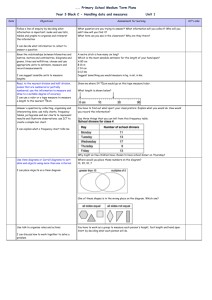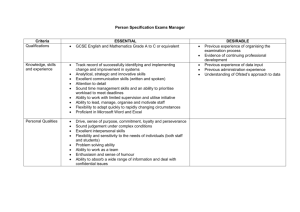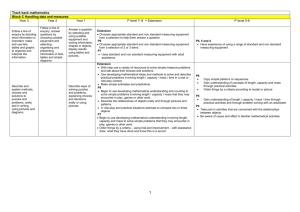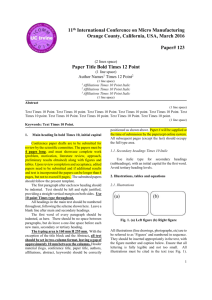Year 2 and 3 Medium Term Planning – Block C
advertisement
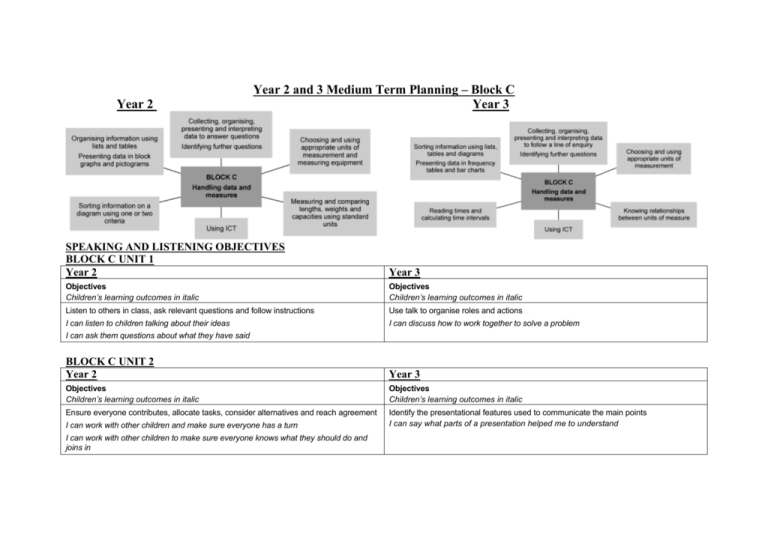
Year 2 Year 2 and 3 Medium Term Planning – Block C Year 3 SPEAKING AND LISTENING OBJECTIVES BLOCK C UNIT 1 Year 2 Year 3 Objectives Children’s learning outcomes in italic Objectives Children’s learning outcomes in italic Listen to others in class, ask relevant questions and follow instructions Use talk to organise roles and actions I can listen to children talking about their ideas I can discuss how to work together to solve a problem I can ask them questions about what they have said BLOCK C UNIT 2 Year 2 Year 3 Objectives Children’s learning outcomes in italic Objectives Children’s learning outcomes in italic Ensure everyone contributes, allocate tasks, consider alternatives and reach agreement Identify the presentational features used to communicate the main points I can say what parts of a presentation helped me to understand I can work with other children and make sure everyone has a turn I can work with other children to make sure everyone knows what they should do and joins in When we work together we all think about different ways we can do something We can agree on what we should do BLOCK C UNIT 3 Year 2 Year 3 Objectives Children’s learning outcomes in italic Objectives Children’s learning outcomes in italic Explain their views to others in a small group; decide how to report the group’s views to the class Explain a process or present information, ensuring items are clearly sequenced, relevant details are included and accounts ended effectively I can explain a diagram that shows our results and I can use different parts of the diagram to help me I can explain how we found the information needed to solve a problem. I can explain each step in order BLOCK C UNIT 1 (autumn) 2 weeks Year 2 Objectives Children’s learning outcomes in italic Year 3 Objectives Children’s learning outcomes in italic Follow a line of enquiry; answer questions by choosing and using suitable equipment and selecting, organising and presenting information in lists, tables and simple diagrams I can decide what information I need to answer a question I can put information in lists or tables Answer a question by collecting and recording data in lists and tables; represent the data as block graphs or pictograms to show results; use ICT to organise and present data I know how to collect information I can use lists and tables to show what I found out Use lists, tables and diagrams to sort objects; explain choices using appropriate language, including ‘not’ I can sort objects and talk about how I sorted them Follow a line of enquiry by deciding what information is important; make and use lists, tables and graphs to organise and interpret the information Estimate, compare and measure lengths, weights and capacities, choosing and using standard units (m, cm, kg, litre) and suitable measuring instruments I can find out if something is longer or shorter than a metre I can find out if something will hold a litre of water I can use a balance to compare two things to see which is lighter Read, to the nearest division and half-division, scales that are numbered or partially numbered; use the information to measure and draw to a suitable degree of accuracy I can decide what information to collect to answer a question Answer a question by collecting, organising and interpreting data; use tally charts, frequency tables, pictograms and bar charts to represent results and illustrate observations; use ICT to create a simple bar chart I can explain what a frequency chart tells me Use Venn diagrams or Carroll diagrams to sort data and objects using more than one criterion I can place objects on a Venn diagram I can use a ruler or a tape measure to measure a length to the nearest 12 cm Know the relationships between kilometres and metres, metres and centimetres, I can use a balance to find out if something is lighter or heavier than a kilogram or half-kilogram kilograms and grams, litres and millilitres; choose and use appropriate units to estimate, measure and record measurements I can suggest sensible units to measure lengths BLOCK C Unit 2 (spring) 2 weeks Year 2 Objectives Children’s learning outcomes in italic Follow a line of enquiry; answer questions by choosing and using suitable equipment and selecting, organising and presenting information in lists, tables and simple diagrams I can organise information and make lists and tables Answer a question by collecting and recording data in lists and tables; represent the data as block graphs or pictograms to show results; use ICT to organise and present data I can make block graphs and get information from other people’s graphs Use lists, tables and diagrams to sort objects; explain choices using appropriate language, including ‘not’ I can sort objects and use diagrams to show how I sorted them Estimate, compare and measure lengths, weights and capacities, choosing and using standard units (m, cm, kg, litre) and suitable measuring instruments I can estimate whether a container holds more or less than a litre I can estimate whether an object is heavier or lighter than a half- kilogram by putting a half-kilogram in one hand and the object in the other I know how long a metre is and I know how long a centimetre is Read the numbered divisions on a scale, and interpret the divisions between them (e.g. on a scale from 0 to 25 with intervals of 1 shown but only the divisions 0, 5, 10, 15 and 20 numbered); use a ruler to draw and measure lines to the nearest centimetre I can use a ruler or metre stick to measure how long something is I can read numbers on a scale and work out the numbers between them Year 3 Objectives Children’s learning outcomes in italic Follow a line of enquiry by deciding what information is important; make and use lists, tables and graphs to organise and interpret the information I can decide what information to collect to answer a question Answer a question by collecting, organising and interpreting data; use tally charts, frequency tables, pictograms and bar charts to represent results and illustrate observations; use ICT to create a simple bar chart I can show information in a pictogram where each picture represents 2 people Use Venn diagrams or Carroll diagrams to sort data and objects using more than one criterion I can place objects on a Carroll diagram Read the time on a 12-hour digital clock and to the nearest 5 minutes on an analogue clock; calculate time intervals and find start or end times for a given time interval I can find how long a journey took if I know the start and end times Know the relationships between kilometres and metres, metres and centimetres, kilograms and grams, litres and millilitres; choose and use appropriate units to estimate, measure and record measurements I know that temperature can be measured in degrees Celsius Read, to the nearest division and half-division, scales that are numbered or partially numbered; use the information to measure and draw to a suitable degree of accuracy I can read the temperature on a thermometer to the nearest degree BLOCK C Unit 3 (summer) 2 weeks Year 2 Objectives Children’s learning outcomes in italic Follow a line of enquiry; answer questions by choosing and using suitable equipment and selecting, organising and presenting information in lists, tables and simple diagrams I can test out an idea by collecting and organising information Answer a question by collecting and recording data in lists and tables; represent the data as block graphs or pictograms to show results; use ICT to organise and present data I can use ICT to show results Use lists, tables and diagrams to sort objects; explain choices using appropriate language, including ‘not’ I can sort objects in different ways and explain how I sorted them Estimate, compare and measure lengths, weights and capacities, choosing and using standard units (m, cm, kg, litre) and suitable measuring instruments I can measure length, using a metre tape or a ruler I can measure in centimetres/metres I can use a measuring jug to measure a litre of water and to find out how much water other containers hold I can measure weight in kilograms and half-kilograms Read the numbered divisions on a scale, and interpret the divisions between them (e.g. on a scale from 0 to 25 with intervals of 1 shown but only the divisions 0, 5, 10, 15 and 20 numbered); use a ruler to draw and measure lines to the nearest centimetre I can read scales marked in 5s and 10s I can measure and draw lines to the nearest centimetre Year 3 Objectives Children’s learning outcomes in italic Follow a line of enquiry by deciding what information is important; make and use lists, tables and graphs to organise and interpret the information I can decide what information to collect to answer a question I can choose how to show others what I have found out Describe and explain methods, choices and solutions to puzzles and problems, orally and in writing, using pictures and diagrams I can explain how the class used information to solve a problem Answer a question by collecting, organising and interpreting data; use tally charts, frequency tables, pictograms and bar charts to represent results and illustrate observations; use ICT to create a simple bar chart I can show information in a tally chart or bar chart Know the relationships between kilometres and metres, metres and centimetres, kilograms and grams, litres and millilitres; choose and use appropriate units to estimate, measure and record measurements I can choose suitable units to estimate and measure length Read, to the nearest division and half-division, scales that are numbered or partially numbered; use the information to measure and draw to a suitable degree of accuracy I can read a scale to the nearest division or half-division
